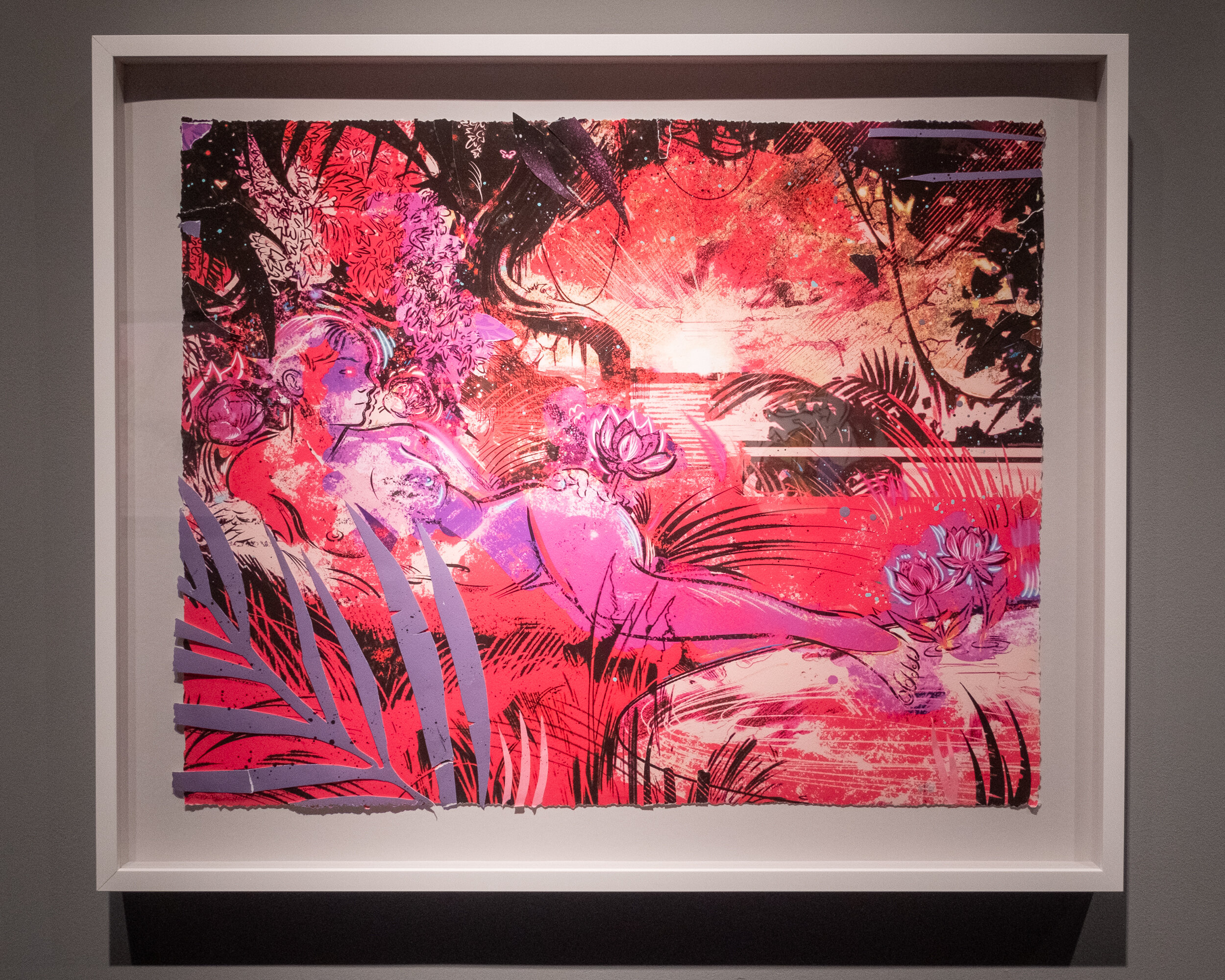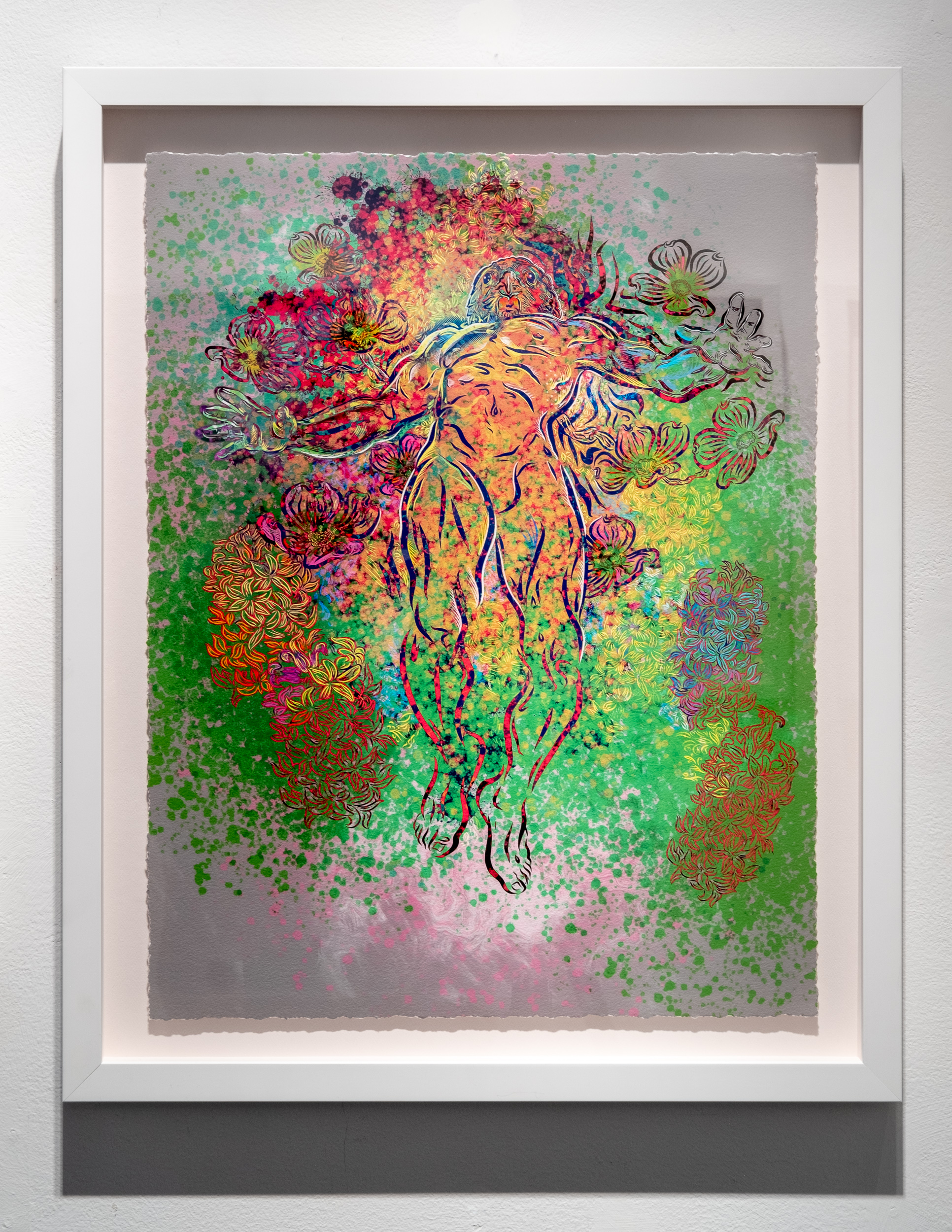Tell us a little bit about your art. Do you consider these recent works drawings, paintings, printmaking, or something else?
All of the above! My work usually combines painting techniques with techniques that are associated with graphic art or illustration. I was an illustration major in college, but I petitioned the administration to allow me to take painting classes as a supplement to my illustration curriculum. I was that weird guy who used oil paints to finish his illustration assignments and inks to finish his painting projects. I’ve always found that the establishment uses flimsy criteria to distinguish between different disciplines in art making, so I continue to have my own multidisciplinary approach.
There seems to be an otherworldly, psychedelic quality to your work. Where does that aesthetic come from?
I believe that just comes about naturally as I spend time working with the subject matter. These pictures often start as sketches I make from observation in daily life. But the finished image comes together weeks later in the studio, and at that point I’m relying on a combination of drawings and photo references but mostly on recollections. I’ve always been interested in the way that memory changes over time, allowing certain details of a story to become more pronounced or exaggerated, while others become more vague. I lean into that process when I’m working, and I let my pictures take on a life of their own, sort of the way a rumor takes on a life of its own after being repeated enough times. As I make changes to the art, I usually let those changes remain visible to the viewer. That allows for a sense of time to be represented in the image, because the different layers of development are evident. I love making art that strikes other people as psychedelic, but really life itself is pretty psychedelic when you start looking deeply at it.
Tell us a little about your approach to color. You seem to enjoy using neon color schemes and thick lines.
“Neon Schemes and Thicc Lines.” That sounds like a great name for a club! Some of that comes from a Pop sensibility and some of it is simply a formal preference. I’d say that I consider line-work to be the “bones” of my paintings. If the bones are strong enough, then I can really push the limits of the color without the whole thing falling apart. I spend a lot of time getting really precise about the line arrangements just so that I can work loosely and intuitively with the color at the very end. Another analogy is that line-work acts like a rhythm section does in a piece of music. It provides structure for the chromatic points of the melody. There are times when I do prefer more reserved color schemes, but in general I feel like art without powerful color is like music without catchy melodies.
You refer to Greek mythology in a few of your pieces. What draws you to mythology and how does it inform your practices?
Myths are just stories that have been told too many times. They’re stories that usually explore the phenomena of ordinary life but with extraordinary characterizations. That’s basically what I want my art to be as well. I find well known myths or parables useful because they’re common points of reference. I often make art based on narratives that are very, very personal to me, but I find frameworks for those stories within mythology. Presenting a personal story as a myth helps the viewer understand the scene. I think art should have a little something familiar and a little something new in it. Look around and you’ll find that to be the case with everything from Broadway’s Hamilton to pretty much anything Disney is producing for TV these days.
What emotions are you most interested in investigating in your work, and why?
Emotions are a tricky thing to approach in a deliberate way. I tend to just roll with whatever I’m feeling at the time. I will say that the feelings and aesthetics which activated my imagination as a child work pretty strongly on me today. I always stop midway through making art and ask myself if the 12 year old Stan would like it or not. If that answer is “yes,” then I know I’m headed in the right direction.
How does your choice of media inform your content? How do the means speak to the ends?
Often my choice of media IS part of the content. Going back to the subject of childhood, I wasn’t a kid that fell in love with art by visiting museums. I don’t think I voluntarily entered an art museum until I was 18. Instead I found art inside comic books, and on the covers of raggedy paperbacks at the school library, and in those cheaply-printed color cartoons in the Sunday paper. So my love affair with art was a love affair with printed work and with paper itself. It wasn’t just books and comics either. Brightly colored paper is what candy comes wrapped in. It’s what’s left over when fireworks explode. I actually have a picture of La Perla, San Juan in your gallery now and it is partially made of discarded firework paper I found while visiting Puerto Rico. Paper is just fun, and besides that, it’s one of the oldest and most effective vehicles for communication we have. It’s a noble and universal media that still holds its own against the deluge of digital imagery we’re exposed to in the world.
Speaking of digital imagery, explain to us how it factors into your practice.
Like most people, I have a phone on me at all times. Being able to pull it out and make a sketch with my fingertip in seconds, and instantly cycle through different color or layout possibilities is incredible. I have several years worth of my own drawings in the palm of my hand at any time, along with thousands of pictures of my lived experience. Tablet and cellphone technology has helped me immensely because when inspiration strikes, I’m able to engage with it immediately instead of spending time mixing colors or preparing a substrate. Any tool that helps me narrow the time between thought and expression is useful, otherwise the muse often escapes. Printing technology allows me to transfer those designs to large swaths of watercolor paper or even canvas. I often start with multiple versions of an image in that way and take them in different directions until I settle on one “final” version. Sometimes the final version is made by combining all of the alternative takes into one picture. Having digital references is also super helpful with collage techniques because I can create a lot of variations of any one element and reorganize them until I have something that fits.
Do you have a favorite piece of yours?
Just myself! #workinprogress





























































